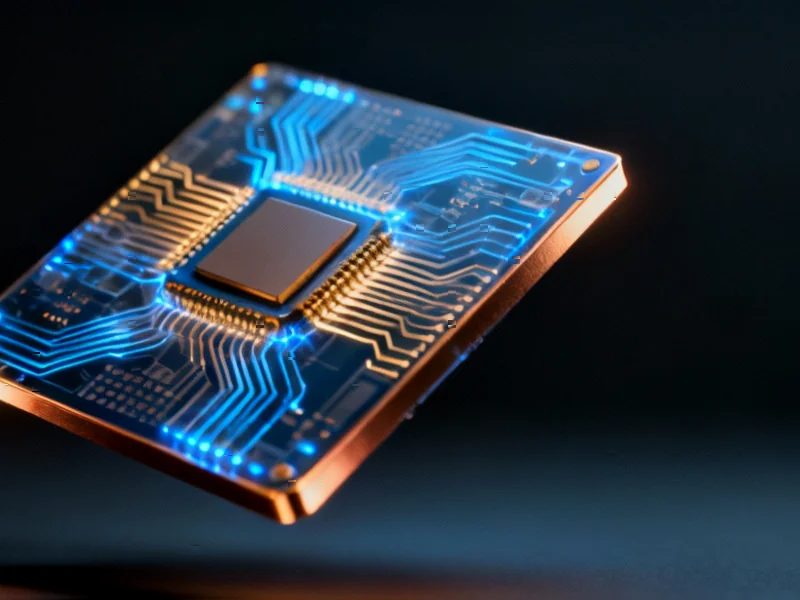Dataflow Computing Breakthrough Claimed
According to reports, Israel-based Next Silicon has developed a new processor architecture that could potentially disrupt the computing landscape. Sources indicate the company’s Maverick-2 accelerator implements what analysts describe as an “Intelligent Compute Architecture” based on dataflow principles, a approach that has historically struggled with programmability and practicality challenges.
Table of Contents
Rethinking Traditional Computing Models
The report states that modern computing has been dominated by the Von Neumann architecture for decades, with both CPUs and GPUs requiring significant silicon resources for instruction management rather than actual computation. Next Silicon’s proposition reportedly offers a fourth path – combining ASIC-like efficiency with GPU-level parallelism and CPU flexibility.
Analysts suggest the Maverick-2’s dataflow execution fabric represents a fundamental shift from traditional processor design. Instead of using a program counter to sequence instructions, the chip’s arithmetic logic grid activates when input data becomes available, similar to an automated factory where work begins immediately when materials arrive.
Performance and Efficiency Claims
According to the company‘s internal benchmarks, Maverick-2 reportedly achieves up to 10 times the performance of top-tier GPUs while consuming 60 percent less power. Perhaps more significantly, sources indicate these performance gains come while running completely unmodified C++, Python, Fortran, and even Nvidia CUDA code.
The technology‘s adaptability appears to be another key advantage. Reports suggest Maverick-2’s software layer profiles existing code in real-time, identifies computational hotspots, and dynamically reconfigures compute resources using what the company calls “Mill Cores” – specialized hardware configurations built and compiled automatically based on runtime behavior.
Production Validation and Ecosystem Challenges
Unlike many early-stage architectures, Maverick-2 isn’t merely theoretical. The chip is reportedly already deployed in systems at Sandia National Laboratories’ Spectra supercomputer, where it’s undergoing production-scale testing. This deployment suggests the technology has progressed beyond laboratory demonstrations.
However, analysts caution that semiconductor success depends heavily on ecosystem maturity, not just raw performance. Next Silicon faces the significant challenge of integrating its architecture into existing HPC and AI frameworks, requiring support for profilers, debugging tools, and runtime schedulers that currently favor established players.
Broader Industry Implications
If Next Silicon’s claims are validated independently, the technology could potentially carve out niches in HPC, simulation, and AI-driven scientific research where efficiency and throughput are paramount. The company’s “drop-in programmability” approach, if proven effective, might also open doors in hyperscale data center acceleration and big data analytics.
Longer term, industry observers suggest Maverick-2’s success could push competitors to reconsider traditional architecture assumptions. With Nvidia already developing tightly coupled CPU-GPU designs through its Grace-Blackwell architecture, the computing industry appears to be entering a period of significant architectural experimentation.
Next Silicon’s technology represents one of the most credible attempts to commercialize dataflow computing, but its ultimate success will depend on proving that developers and customers can adopt it easily and profitably within existing computing ecosystems.
Related Articles You May Find Interesting
- GE Vernova Stock Dips Despite Robust Earnings and Record Backlog – Analysts Spot
- Applied Digital’s $5 Billion AI Infrastructure Deal Signals Major Industry Shift
- Strategic Merger Creates AWS Powerhouse: Caylent and Trek10 Unite for End-to-End
- Google’s Quantum Echoes Break New Ground in Computational Chemistry and NMR Anal
- Apple’s A20 Chip Dilemma: Balancing Innovation and Affordability in Next-Gen iPh
References & Further Reading
This article draws from multiple authoritative sources. For more information, please consult:
- https://www.nextsilicon.com/
- https://www.sandia.gov/research/news/sandia-partners-with-nextsilicon-and-penguin-solutions-to-deliver-first-of-its-kind-runtime-reconfigurable-accelerator-technology/
- http://hpcchallenge.org/hpcc/
- https://www.hpcg-benchmark.org/
- https://www.nextsilicon.com/maverick
- http://en.wikipedia.org/wiki/Dataflow_architecture
- http://en.wikipedia.org/wiki/Dataflow
- http://en.wikipedia.org/wiki/Silicon
- http://en.wikipedia.org/wiki/Computing
- http://en.wikipedia.org/wiki/Central_processing_unit
This article aggregates information from publicly available sources. All trademarks and copyrights belong to their respective owners.
Note: Featured image is for illustrative purposes only and does not represent any specific product, service, or entity mentioned in this article.



